Shimano Dura-Ace, SRAM Red AXS and Campagnolo Super Record Wireless are the flagship road bike groupsets from the three biggest manufacturers.
These are the most expensive road bike groupsets each brand produces, and the kit you’ll see sponsored WorldTour teams riding.
SRAM Red eTap AXS is the oldest of the bunch. It was released in 2019, but is still commonly specced on top-tier bikes. Its release ushered in the beginning of the AXS era for SRAM, which now covers road, gravel and mountain bike groupsets.
Shimano Dura-Ace R9200 is the second oldest. After protracted teasing, it was released in 2021 and brought wireless shifting to Shimano’s Di2 groupsets for the first time.
Campagnolo Super Record Wireless is the newest. Released in May 2023, the groupset is also wireless.
All three are 12-speed and are available exclusively as electronic groupsets – you can no longer buy a top-tier mechanical groupset from Shimano, Campagnolo or SRAM.
In this in-depth guide, we’ll compare the three brands’ premium groupsets – what each offers and how they function, as well as the all-important weights and prices.
Shimano, SRAM and Campagnolo shifters compared

The design of SRAM, Shimano and Campagnolo's shifters was, for many years, a key point of differentiation between each manufacturer.
However, with Campagnolo ditching its signature thumb shifter, all three now work in a broadly similar fashion.
As with Shimano, Campagnolo now has two shifter buttons on each brake lever. Shimano mounts its shifters one behind the other, while Campag’s are above and below each other.
The functionality of these can be custom-programmed.
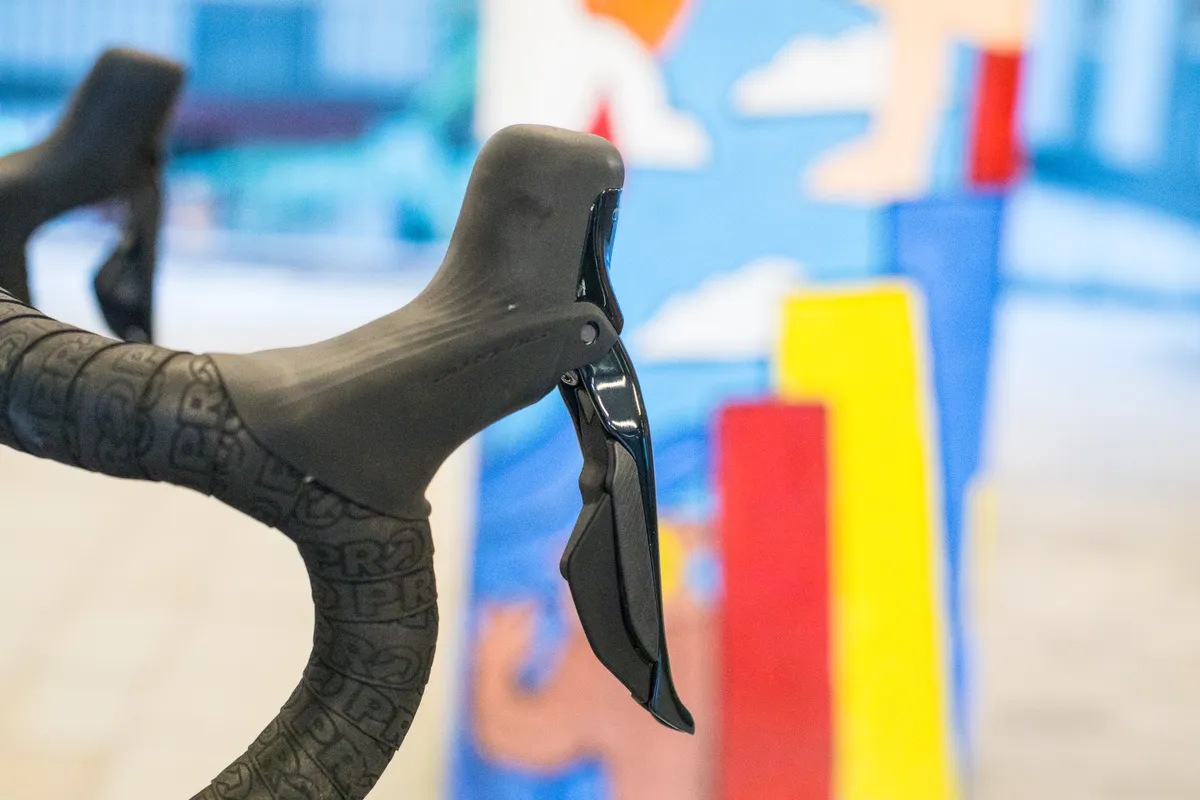
Shimano’s older 11-speed Di2 shift buttons could be difficult to differentiate, particularly when wearing winter gloves. It’s gone some way to addressing this with its 12-speed shifters though, with the two shift buttons more widely separated and the forward shifter raised relative to the rear one. Shimano also integrates auxiliary buttons into the top of the hoods of its Dura-Ace shifters.
Like Campagnolo, the functionality of these buttons can be customised.

SRAM, meanwhile, has just one shift button per brake lever, which makes rear gear changes more intuitive: right shifter to change up, left to change down in standard configuration.
Front changes are also straightforward – you operate both shift levers together to move between chainrings.
Campagnolo and SRAM's wireless design vs Shimano's semi-wireless approach
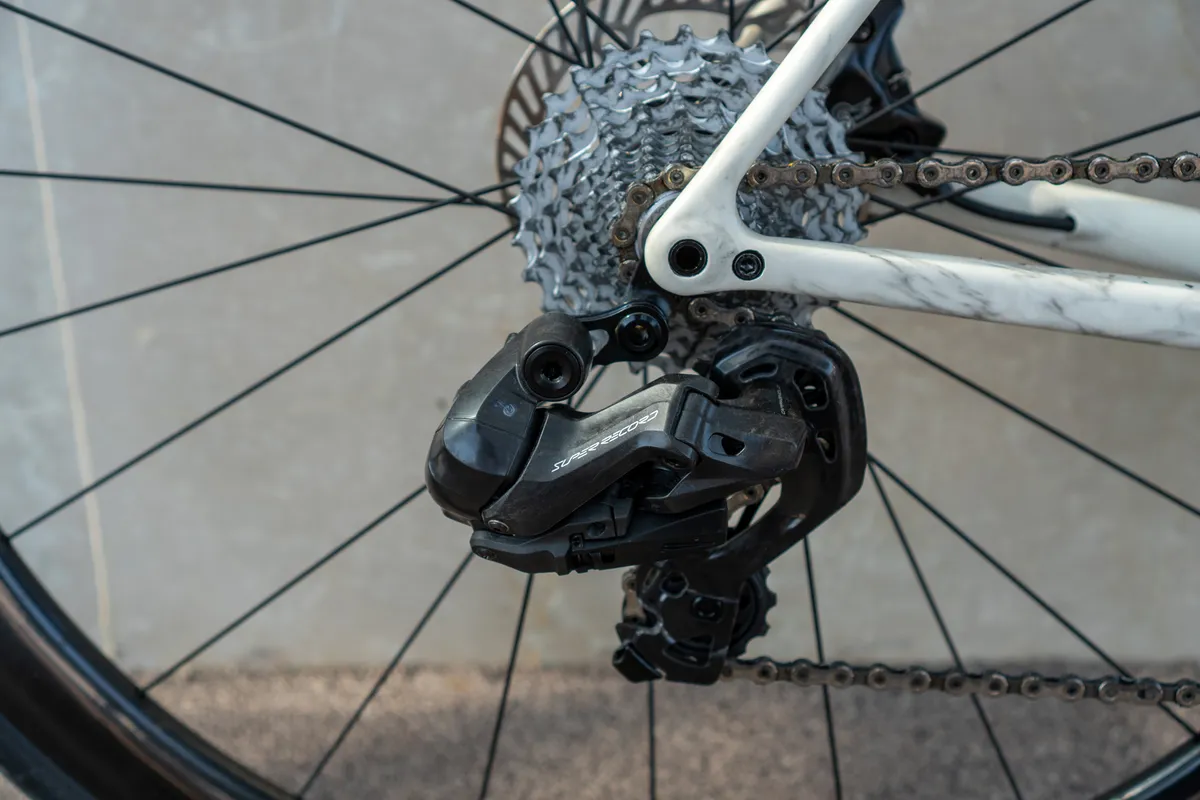
Both Campagnolo Super Record Wireless and SRAM Red AXS groupsets are fully wireless.
As a result, setting up the front and rear derailleurs is an easier task than with wired electronic groupsets.
In contrast, Shimano Dura-Ace is semi-wireless.
The front and rear derailleurs are connected to a central battery, which is usually located inside the seat tube. This makes setup slightly more onerous than Super Record Wireless or Red eTap AXS, but you won't need to route anything through the headset on an integrated bike.
That's unless you use the rim-brake version of the groupset, which is still wired.
Different gearing options
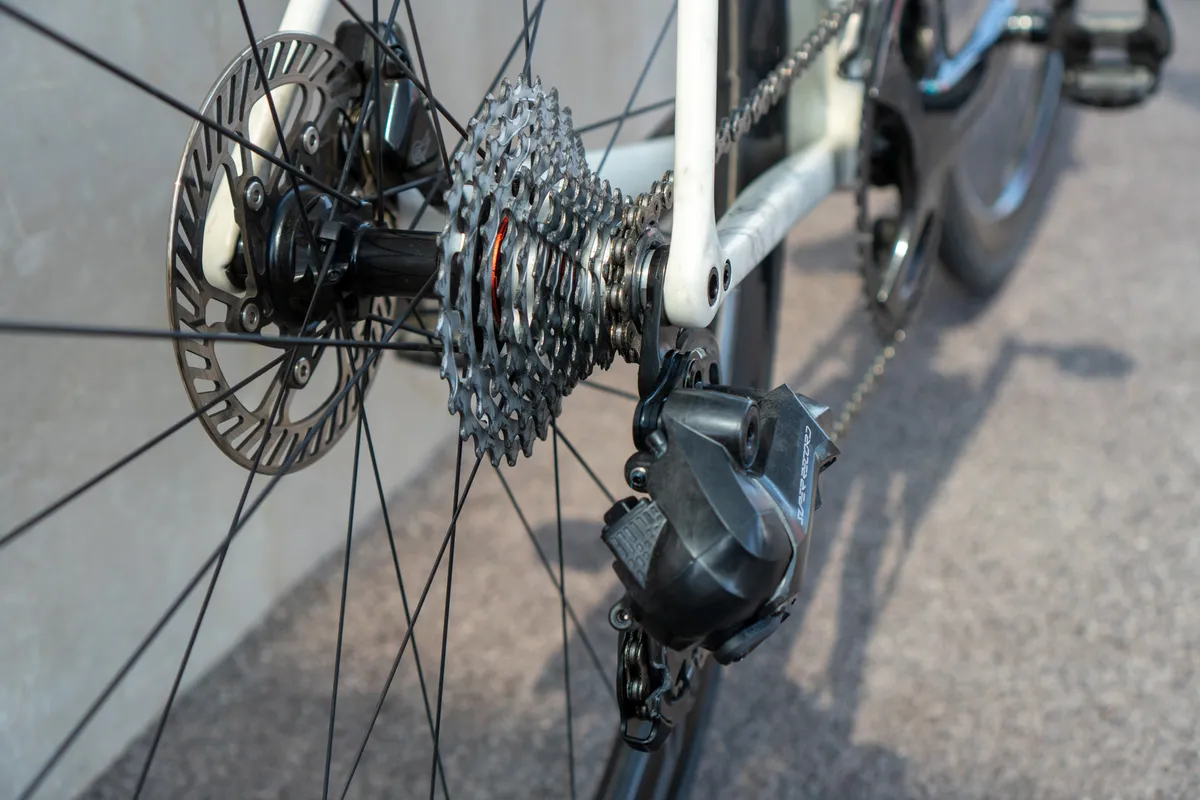
Shimano is now the only one of the big three to stick with cassettes that start with an 11-tooth sprocket.
For a given gear range, this makes everything larger than starting at 10-teeth – you must use larger cassettes and larger chainrings to provide an equivalent top gear.
This equals potentially more weight, although a comparison shows Shimano Dura-Ace weighs approximately the same as SRAM Red and Campagnolo Super Record (see below for more on groupset weights).
Campagnolo has followed SRAM’s lead in starting with 10 teeth on its cassettes. It provides 10-25t, 10-27t and 10-29t options.
SRAM Red offers a wider range than Campagnolo though, with 10-26t, 10-28t and 10-33t cassettes. There’s also a Force-level 10-36t cassette, but this is only compatible with the 36t maximum-rated Red rear derailleur, which in turn won’t handle the 10-26t cassette.
You can’t run the larger cassette with the 33t-rated version of the SRAM Red AXS derailleur, so you need to choose what range of compatibility you want when purchasing a Red groupset.
The larger-range cassettes are part of the sell for SRAM’s X-Range gearing, which it says results in fewer front shifts and leads to more efficient riding.
Shimano offers Dura-Ace cassettes in 11-30t and 11-34t ranges. The 11-28t cassette promised at launch is still not commercially available.
Wheel compatibility
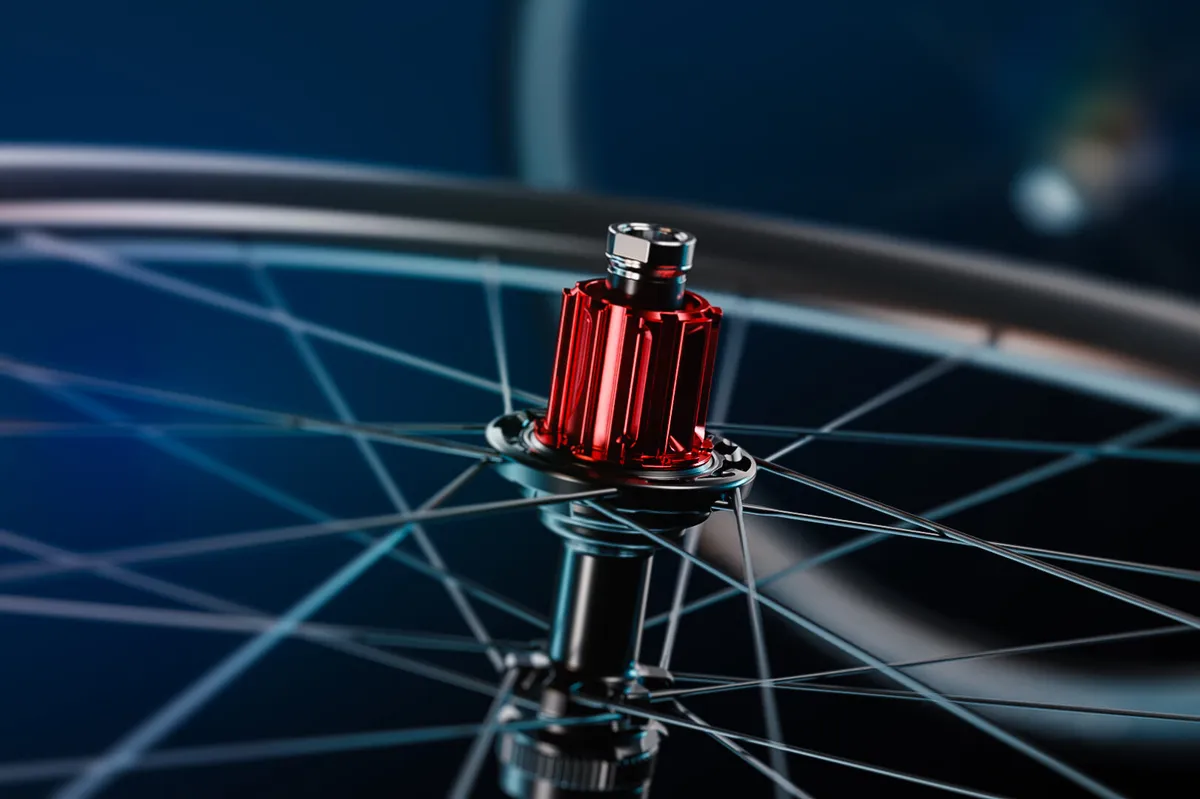
When you're considering which road bike wheels will work with one of these three groupsets, you need to consider which freehub is on the wheels:
- Campagnolo cassettes fit on the brand's N3W freehub body
- SRAM Red cassettes need an XDR freehub
- Shimano's 12-speed cassettes work with the brand's new 12-speed road freehub, though they're also backwards-compatible with HG-style freehubs
It's possible to change the freehub body on some wheels to cassettes from different groupsets.
Crankset options compared
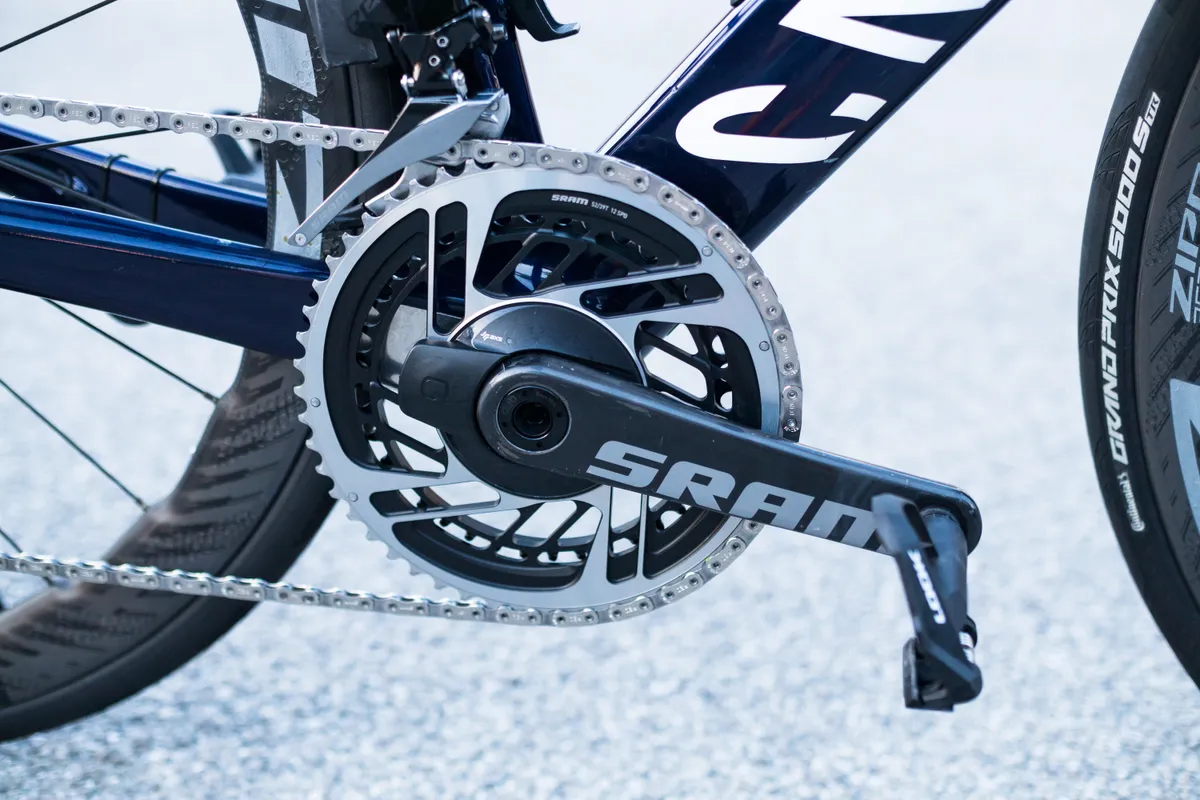
You can choose between 50/34t, 48/32t and 45/29t Campagnolo Super Record chainrings.
SRAM Red offers 50/37t, 48/35t and 46/33t double chainrings. So, although its large ring sizes are similar, its chainrings don’t provide such a big jump between the two rings as Campagnolo.
This compensates for Campagnolo’s more closely spaced cassettes and results in both groupsets offering a comparable gear range. With SRAM, you will need to make fewer front shifts, while with Campagnolo the jumps between gears are smaller at lower ratios.
If you like to push a big gear, you can buy a SRAM chainring set with 52/39t, 54/41t and 56/43t configurations. Campagnolo says it may produce larger chainrings to satisfy pro riders, too.

Shimano Dura-Ace cranksets provide 54/40t, 52/36t and 50/34t options, which along with its wide-ranging cassettes offer a much greater range than the pro-level groupsets of old.
SRAM Red chainrings are direct mount and made as one piece, whereas Campagnolo and Shimano chainrings are interchangeable on the crank-arm spider.
SRAM and Shimano have a double-sided power meter option for their double cranksets, while Campagnolo doesn’t currently offer its own power meter, although there’s a space for a small pod on the crank arms and we reckon that one may be in the works.
Shimano has the most crank-length options, with SRAM second and Campagnolo last.
Shimano Dura-Ace, SRAM Red and Campagnolo Super Record crank-length options compared
| 160mm | 165mm | 167.5mm | 170mm | 172.5mm | 175mm | 177.5mm | |
|---|---|---|---|---|---|---|---|
| Campagnolo Super Record | X | X | X | X | |||
| SRAM Red AXS | X | X | X | X | X | X | |
| Shimano Dura-Ace Di2 | X | X | X | X | X | X | X |
Disc brakes reign supreme

All three brands are focused on hydraulic disc brakes. This should come as no surprise – most high-end bikes are now disc-brake only.
Shimano and SRAM offer a get-out rim brake configuration for the die-hards, but Campagnolo has gone all-in on disc brakes, despite being last to the party.
Campagnolo says its disc brakes are efficient enough to avoid excessive heat build-up without resorting to cooling fins on the disc brake rotors.
That’s true, too, of SRAM’s HRD brakes, whereas Shimano Dura-Ace rotors incorporate a cooling fin on their design and you can spec pads with cooling fins as well. Shimano says this Freeza tech helps to reduce rotor heat by up to 100°C.
All three brands offer reach adjustment at this top-spec level. Unlike SRAM and Shimano, Campagnolo doesn’t offer bite-point adjustment.
Battery life
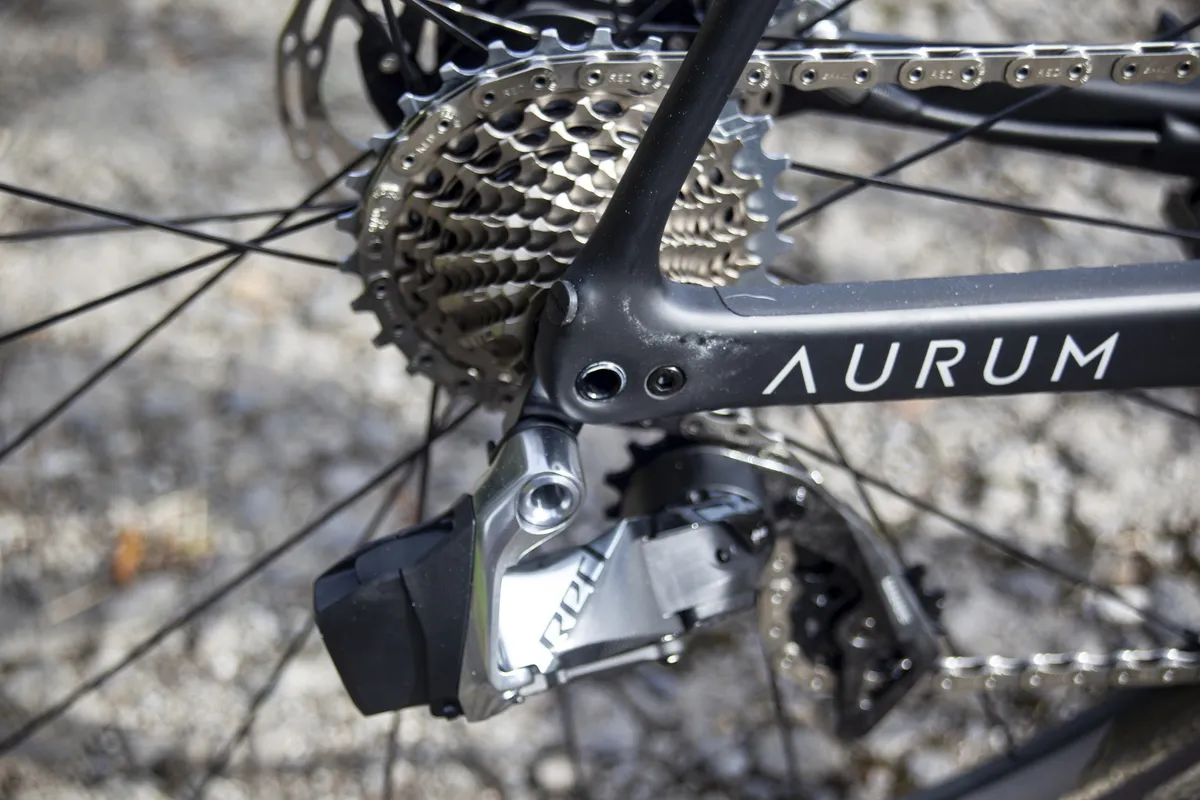
Campagnolo quotes a 750km derailleur battery range with heavy use, or up to 1,000km with less intensive shifting, which is similar to Shimano’s claimed 1,000km.
Confusingly, SRAM quotes in hours: 60 of them.
In practice, battery range is likely to be similar between the three systems.
SRAM enables you to swap batteries between derailleurs if the more-often-used rear derailleur battery gives up.
That’s not an option with Campagnolo because the battery shapes are different, so you’ll need to struggle home with a single rear ratio. Campagnolo says a future firmware upgrade will enable you to select which gear ratio this is.
Shimano’s single battery prioritises rear shifting if it’s short on juice, so its get-me-home functionality is an advantage over Campagnolo’s. You also get some warning of the low battery once the front derailleur gives up.
All three systems use coin cells to power the shifters and all three claim around a two-year battery life.
Charging
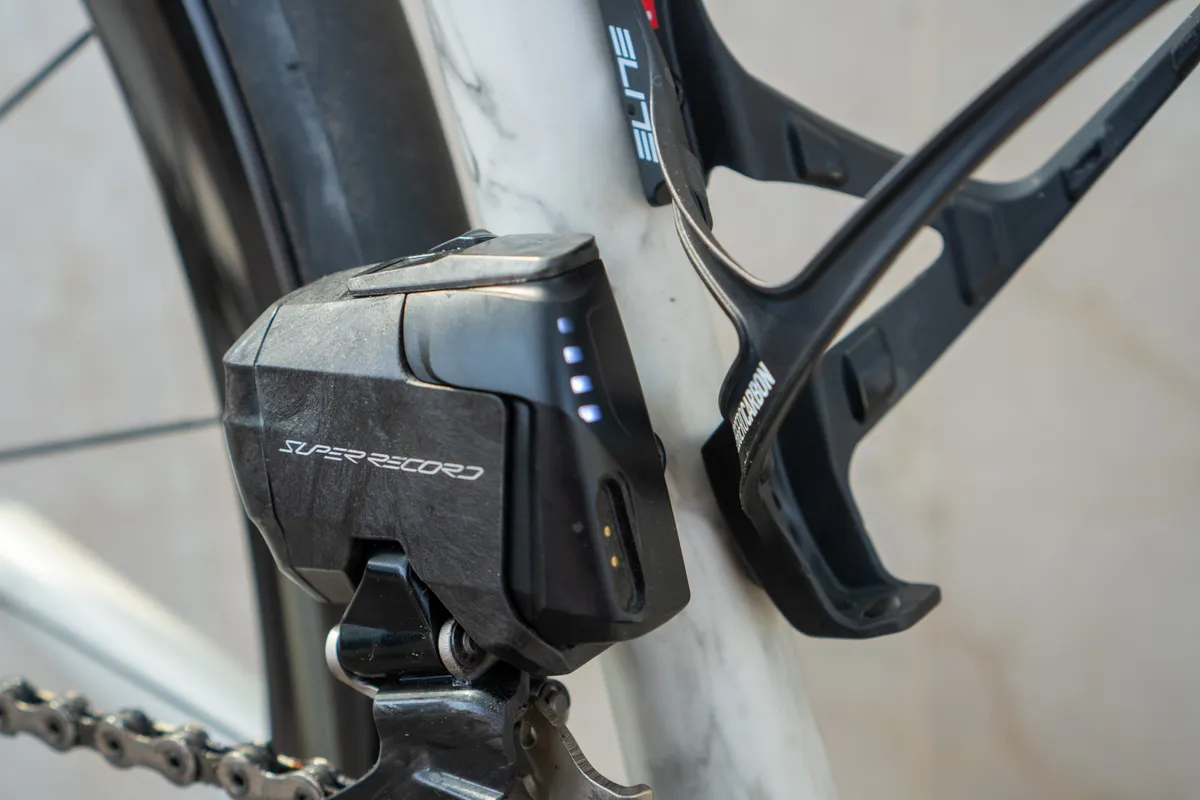
Campagnolo has the upper hand over its rivals with its charging tech, because it offers both on-bike and off-bike charging, thanks to a magnetic charging interface.
In contrast, Shimano’s internal battery is only chargeable on-bike via the magnetic charge port in the rear derailleur, which means you need a wall socket conveniently nearby.
SRAM only offers off-bike charging via its USB docking station. This has the advantage that you can take your batteries somewhere convenient to charge, but the disadvantage of having to unhook your batteries from your derailleurs every time you need to charge them.
In reality, this isn’t such an arduous task and both SRAM’s new four-battery charger and its updated single-battery charger do the job in double-quick time via USB-C. A full charge is claimed to take 60 minutes.
Campagnolo also offers fast charging, claiming a 90 per cent charge in 45 minutes and a full charge in 60 minutes. Quoted time for a full recharge of a Shimano Di2 battery is between 1.5 and 3 hours.
Shimano Dura-Ace, SRAM Red and Campagnolo Super Record weights compared

The new Super Record wireless groupset weighs 2,520g in its lightest configuration, according to Campagnolo. That compares with the claimed weight for a SRAM Red groupset of 2,518 grams, although you can add 36g to that for a power meter.
Meanwhile, we weighed Shimano Dura-Ace at 2,514g when we tested it, but that did include a power meter.
As always, actual weight is highly dependent on configuration and whether you include the small parts such as Shimano’s battery mounting kit and rotor lockrings. However, weight-wise it’s a dead heat between the three brands.
High prices
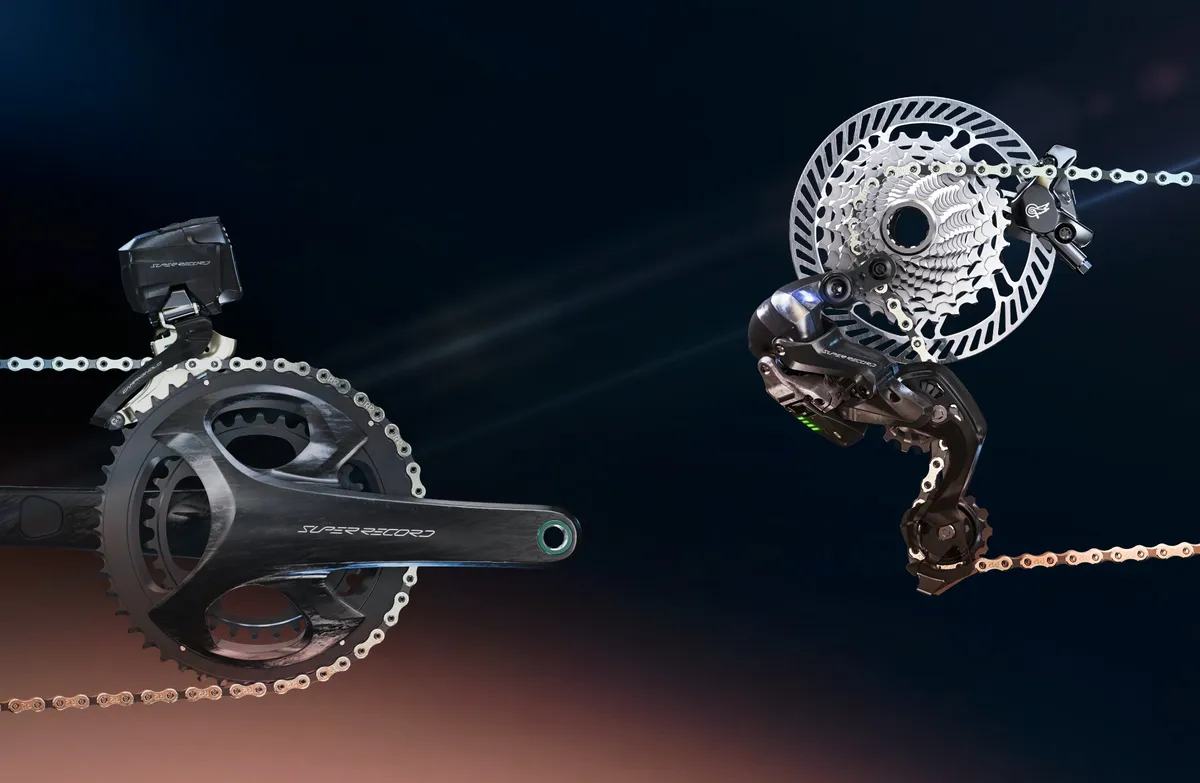
If you want a pro-level groupset, you’re going to pay for it, regardless of which brand you choose.
As with weight, price is highly dependent on the options chosen, but a complete Shimano Dura-Ace groupset costs around £3,600 at full retail price.
A complete SRAM Red groupset is slightly less expensive, at around £3,400.
Meanwhile, Campagnolo Super Record retails for €5,200, or around £4,500, maintaining its premium positioning.
Discounting means you can buy groupsets for a significantly lower price though, at least for SRAM and Shimano.
Cheaper options
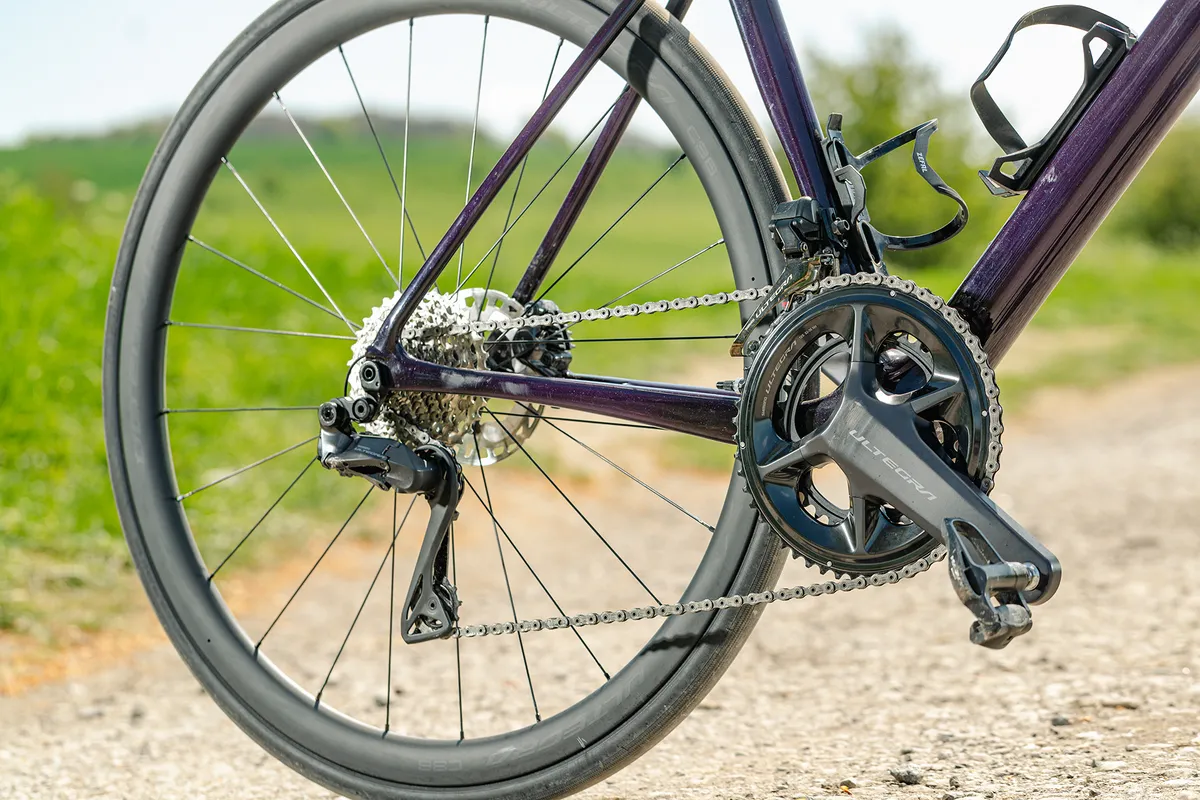
Both SRAM and Shimano offer cheaper electronic-shifting groupset options, as well as their premium groupset.
In SRAM’s case, its AXS groupsets are available at Force and Rival levels, as well as Red.
Shimano has Ultegra and 105 Di2 as less expensive electronic groupsets.
The new wireless Campagnolo groupset, as with its predecessor wired version, continues to be offered at Super Record level only. Campagnolo formerly offered wired electronic shifting at Record and Chorus level though, and it hinted to us at launch that its new wireless tech may trickle down in future.
Both SRAM and Shimano offer electronic gravel groupsets as well, although Shimano GRX RX815 Di2 is currently only 11-speed.
SRAM has a wider-range, single-ring Red XPLR rear derailleur and cassette offering extended gear range for gravel riders (and Primož Roglič on the final mountain stages of the 2023 Giro d’Italia). Will we see an electronic Campagnolo Ekar gravel groupset alongside the current mechanical version in future?
undefinedundefinedundefinedundefinedundefinedundefinedundefinedundefinedundefinedundefinedundefinedundefinedundefinedundefinedundefinedundefinedundefinedundefinedundefinedundefinedundefinedundefinedundefinedundefinedundefinedundefinedundefinedundefinedundefinedundefinedundefinedundefinedundefinedundefinedundefinedundefinedundefinedundefinedundefinedundefinedundefinedundefinedundefinedundefinedundefinedundefinedundefinedundefinedundefinedundefinedundefinedundefinedundefinedundefinedundefinedundefinedundefinedundefinedundefinedundefinedundefinedundefinedundefinedundefinedundefinedundefinedundefinedundefinedundefinedundefinedundefinedundefinedundefinedundefinedundefinedundefinedundefinedundefinedundefinedundefinedundefinedundefinedundefinedundefinedundefinedundefinedundefinedundefinedundefinedundefinedundefinedundefinedundefinedundefinedundefinedundefinedundefinedundefinedundefinedundefinedundefinedundefinedundefinedundefinedundefinedundefinedundefinedundefinedundefinedundefinedundefinedundefinedundefinedundefinedundefinedundefinedundefinedundefinedundefinedundefinedundefinedundefinedundefinedundefinedundefinedundefinedundefinedundefinedundefinedundefinedundefinedundefinedundefinedundefinedundefinedundefinedundefinedundefinedundefinedundefinedundefinedundefinedundefinedundefinedundefinedundefinedundefinedundefinedundefinedundefinedundefinedundefinedundefinedundefinedundefinedundefinedundefinedundefinedundefinedundefinedundefinedundefinedundefinedundefinedundefinedundefinedundefinedundefinedundefinedundefinedundefinedundefinedundefinedundefinedundefinedundefinedundefinedundefinedundefinedundefinedundefinedundefinedundefinedundefinedundefinedundefinedundefinedundefinedundefinedundefinedundefinedundefinedundefinedundefinedundefinedundefinedundefinedundefinedundefinedundefinedundefinedundefinedundefinedundefined